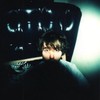Yamantaka Eye of Hanatarash on the fateful bulldozer. PHOTO: GIN SATOH
This article originally appeared on VICE France.Tokyo, 1985: After making his audience sign a waiver, Yamantaka Eye, the frontman of the Japanese noise band Hanatarash, drove a bulldozer through the side of the venue and proceeded to destroy the stage. He was about to nonchalantly throw a Molotov cocktail (AKA a bottle bomb) at the crowd when audience members stopped him.Eye’s dramatic stunt was the latest in a series of increasingly violent antics, that ultimately led Japanese authorities to ban the band from live shows altogether. On another occasion, Eye sliced a dead cat in half with a machete and threw its remains into the crowd. Once he came out on stage with a circular saw strapped to his back – he’d rigged the tool to never stop running, and narrowly avoided amputating his own leg during the performance. Needless to say, the band quickly attracted a lot of attention from both fans and the police. At another show, Eye asked his audience to sign another waiver before tossing bits of broken glass and destroyed machinery into the crowd. With the authorities on their case, the group came together for one last, noise-filled act featuring the same bulldozer. Hanatarash disbanded shortly after, having been together for just one year. In 1990, the band reunited and made music again until 1998 - minus the intense violence.Hanatarash, which roughly translates to “whiner” in Japanese, is mainly remembered for their outlandish gigs, but there’s more to the band than that. Their deluge of performative chaos and destruction is part of a wider artistic vision more commonly known as noise, an art form in its own right with roots in the avant-garde musical and artistic movements of the 20th century.Noise is the art of non-music – or, more precisely, noise music. “Ancient life was all silence,” writes Luigi Russolo – the Italian painter and composer credited with theorising the noise art movement – in his futurist manifesto The Art of Noises. “In the 19th century, with the invention of the machine, noise was born,” he continues. “Today, noise triumphs and reigns supreme over the sensibility of men.”The vast field of noise music and art basically involves taking inspiration from urban environments, so often inhospitable and teeming with sounds that disturb and bother us. Over the 20th century, different artistic movements experimented with noise, from the Fluxus music composition movement to free jazz, and the Dada movement to the most deconstructed, radical forms of rock.In 1975, American musician Lou Reed brought noise into mainstream culture with his album Metal Machine Music, four long tracks composed entirely of guitar feedback played at different speeds. The release didn’t go down well – it alienated most of his fans and attracted the wrath of traditional critics. Many other genres and sub-genres also tried to incorporating noise into their sound, including power electronics, grindcore, glitch and punk. In the 80s, after the global success of British bands, niche experimental bands began emerging in Germany, including pioneering industrial group Einstürzende Neubauten. Eye met Mitsuru Tabata, the other founding member of Hanatarash, while working as a stagehand at the German band’s concert in Japan. Both of them felt that punk had become too polished and pacified – too mainstream – and decided to resurrect the genre’s most disturbing and revolutionary elements in a new band. The group put out three albums between 1984 and 1985, plus a few records after 1990.Hanatarash’s first three records are rather difficult to listen to. Although they still show some form of artistic direction, they can’t truly be appreciated without their performative context. But that’s also how the band met its demise: Their attempt at bringing noise to Japan was radical, but ultimately, they were destined to fade away thanks to their thirst for violence and destruction. Despite their demise, the noise scene in Japan has grown prominently and become its own sub-genre: Japanoise. After Hanatarash, Eye worked on many solo and collaborative projects. In 1986, he co-founded Boredoms, a band which continued the Hanatarash experience while making space for more structured sounds and layers of melody. Unlike its predecessors, Boredoms has been together for decades and has continuously pushed the limits of rock with lengthy song structures and new psychedelic sounds. One of their most interesting concepts is their live album 77 Boa Drums, which the band recorded on the 7th of July, 2007, in New York. The album consists of a 77-minute live performance with Eye on vocals, electronics and a specially made instrument called Sevena, joined by the three other band members – Yoshimi P-We, Yojiro Tatekawa and Muneomi Senju – and 74 other musicians on the drums. In total, 77 drummers played, plus Eye as member 0. The album was sold in Japan for ¥7,777 (about $47). The show on the 8th of August, 2008, was followed by two events titled 88 Boa Drums, featuring 88 drummers – one in Los Angeles led by Boredoms and one in Brooklyn, led by the experimental rock band Gang Gang Dance.As I listen to Eye’s more recent music, I’ve realised that ever since the beginning, his work has always looked to the future above all else – and probably always will. His syncopated rhythms might not be everyone’s thing, but somewhere out there, there’ll be a kid who's a little more wacky and visionary than most who tunes in. They’ll be the one who’ll find inspiration in these brutally discordant sounds - bulldozer and dead cat not necessary.
Advertisement
Advertisement
Advertisement
